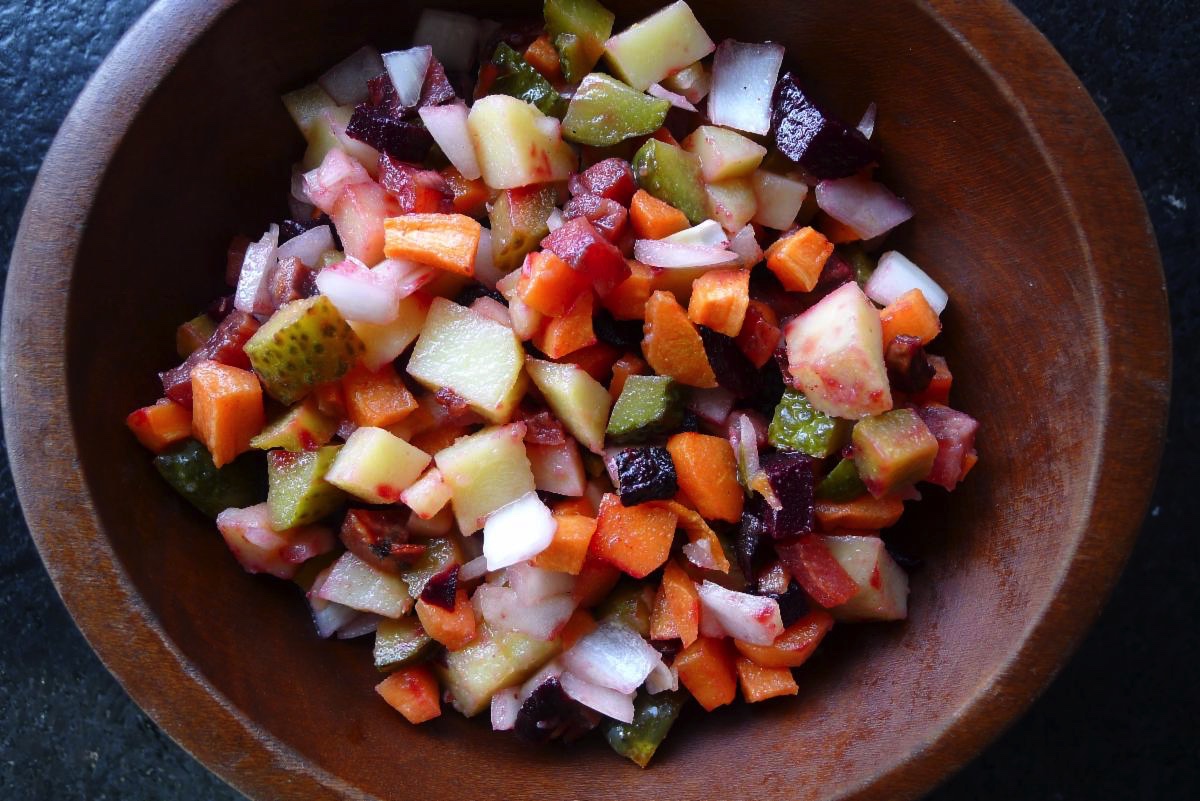Download: word.doc here | Image file here | Return to Editor’s Lounge

Winter came early this year, but the Belarusian farmers at the winter market didn’t seem to mind. They hadn’t brought much, as their cucumbers and tomatoes were long gone, but they were beaming. They had beets. And as far as they were concerned, that was enough.
I like beets too, but not in an everyday way. I wondered how my Belarusian friends sustained their winter-long pace. When I asked the bearded, rosy-faced gentleman how he likes his beets, his grin widened, and he leaned in, as if sharing a valuable secret. He used his callused worker fingers to count off a list of ingredients: “Beets, carrots, potatoes – cooked,” he said, looking me in the eye. “Chopped onions, pickles, salt, little bit of oil.”
“Cut small,” added his wife, beneath a long red parka that matched her husband’s cheeks.
“3/8-inch,” he said, holding two fingers together in the universal symbol for small.
They call this dish beet vinaigrette, and the name caught me off guard at first. It makes me think of beets with balsamic and goat cheese. Instead, the vinegar in the vinaigrette comes from pickles, which are serious business back home in Olshany, Belarus. The village is famous for its mega greenhouses, some of them fitted with ten or more wood stoves to extend the season. The rest of the time, it’s pickles. And beets.
Using pickles as the acid in a salad dressing is about as ingenious as a ten-stove greenhouse. When I went home and made it, the combination of flavors was brilliant too. The pickles, onions and potatoes made a charming combination, invoking the flavor of fries and a mouthful of relish, while the sweetness of the beets played the role of ketchup in what tasted a lot like an all-American meal. It was bright, colorful and cheerful, and despite the logic in the name beet vinaigrette, I began calling the dish Christmas Sweater.
The cold never relented, and at market the next week my friend’s rosy cheeks had darkened to a windblown shade of beet maroon. His wife had stayed home that week, so I handed him my Christmas Sweater. He looked at me skeptically.
“It’s too big,” he said, poking it with the spoon I’d brought. That was when I remembered his 3/8-inch directive. My chunks were more like 5/8-inch, I realized, and I was ashamed that he probably thought I don’t know the difference between 3/8 and 5/8-inch.
“The taste is good,” he acknowledged, sounding surprised to hear himself say it. He agreed to bring some home to his wife, and told me to call that afternoon.
“The flavor is good,” she confirmed. “But it has to be, how do you say. More cute.”
“It’s too ugly?” I asked.
“Yes,” she said, laughing.
I brought Christmas Sweater to Thanksgiving potluck. I made made sure to cut and cube my roots as cute as could be. I would not bring an ugly Christmas Sweater to the party.
At the long table, I wondered if anyone had tried my little side dish. Then, almost on cue, the person to my left started mumbling favorably about “this relish stuff.” Then she wondered aloud who made it. I smiled like a Belarusian beet farmer.
Christmas Sweater
It’s bright, cute, and will keep you warm all winter.
Serves 4 as a side, 2 as a main
2 half-pound potatoes, peeled, each cut in half
1 pound beets, peeled and cubed (see below)
½-pound carrots, peeled and cubed
1 medium onion, cubed
2 cups cubed dill pickles
½ cup olive oil
Salt and pepper, to taste
Steam the potatoes until soft on the outside and still a bit stiff in the middle, about 20 minutes. Remove from heat and allow to cool.
While that is going, peel the carrots and beets, and cube them as cutely as possible. It’s best to do the beets last, or they will stain the cutting board, and the veggies that follow.
Each vegetable will require a slightly different cubing tactic, but there are certain universals. Start by cutting each root in half, lengthwise, and lay the flat sides down. Slicing straight down, make a series of parallel cuts, ⅜-inch apart — that’s half a penny — across each half.
Split your newly-sliced half like a deck of cards. As you pull apart the sliced half-root, it exposes two new flat surfaces — one on each quarter. Holding the slices of each split half together, roll the quarter onto its new flat spot. Spin them around so the flat spots that were facing down now press together.
From here, cut a grid, like the lines on a ⅜-inch piece of graph paper. Slicing straight down, make a series of parallel cuts, ⅜-inch apart. Then turn the knife 90 degrees and make another series of parallel cuts, ⅜-inch apart.
(If your eyes are glazed over after that cubing technique, just cut them into small cute cubes however you can.)
Put the cubed beets and carrots in separate baking dishes and bake at 350 for about a half-hour, stirring each pan once (with separate implements), until they are a little soft and a little crunchy. If they start to shrink that’s a bit too far. Allow the beets and carrots to cool to room temperature. After that the bleeding will be mostly staunched.
While the beets and carrots cook, make sure the cutting board is clean from the beets, and cube the potatoes, onions and pickles.
When everything is cool, cubed and cute, add the salt and oil and gently toss.